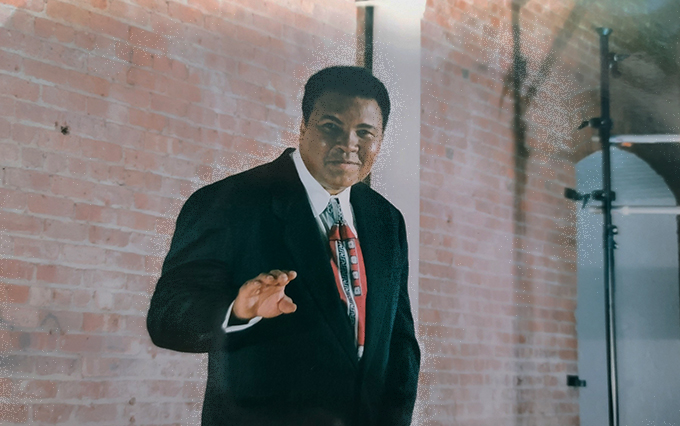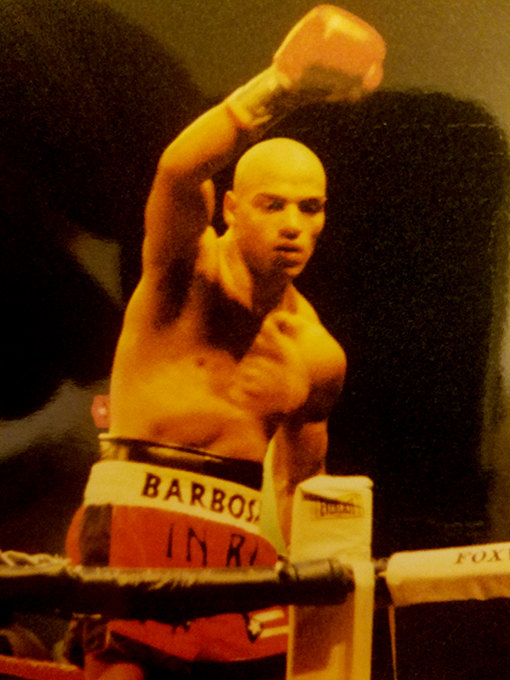“REQUIEM FOR THE WARRIORS”
By Ernest DiStefano

In 2015, after thirty years of experience as a criminal justice professional, of which I spent seventeen years working in a prison, I founded the Comeback Athletes & Artists Network, (CAAN, Inc.), a non-profit organization with the mission of using athletics and the arts to assist at-risk and impoverished communities. My previous work with combat athletes as a co-manager and mental training coach convinced me that these athletes are the most vulnerable and at-risk athletes in the sports world. In this essay, I will use the cause and effect process and medical research to defend this belief. I will also discuss the solutions put forth by others, and our organization’s own solution, for helping to eradicate the oppressive plight of professional combat athletes.
.
PART I: CAUSE & EFFECT
Cause: Poverty
Writer Walter Mosley said, “Poor men box, because it’s the only choice they have. A poor man, of any color, is fighting for his life in the ring. And the only reason they’re fighting for their lives in the ring, is because it’s a little bit safer than fighting for your life on the streets of America.”
Effect: A willingness to risk one’s own life to alleviate those circumstances
In the specific case of boxers and other combat athletes, the risk involved is potential brain injury and/or death from the violent nature of their chosen professions.
Effect: Combat Sports-Related Deaths
In the past 131 years, 1,878 boxers have died as a direct result of injuries sustained in the ring. This is an average of more than fourteen deaths per year and more than one death each month. Prior to that, from 1740 to 1889, when boxers fought bare-knuckled (a sport which is currently growing in popularity), there were 266 documented deaths (“Death in the Boxing,” by Rupert Taylor, April 29, 2021). Since MMA’s inception in the mid-1990’s there have been sixteen reported deaths among MMA fighters directly related to injuries sustained in the Octagon (“How Many Fighters Have Died in the Ring: Boxing and MMA,” by Ross Canning).
A 2014 study by Eastern Michigan University, which examined professional wrestlers who were under the age of sixty-five and active between 1985 and 2011, found that the mortality rates for professional wrestlers were up to 2.9 times higher than the mortality rate for men in the wider United States Population. A separate report in 2014 by John Moriarty of the University of Manchester and Benjamin Morris of FiveThirtyEight found that the mortality rate for professional wrestlers is higher than that of athletes in other sports. It is suggested among experts that a combination of the physical nature of the professional wrestling industry, no off-season, and the drug culture of the 1970’s and 1980’s contributes to the aforementioned high mortality rates for professional wrestlers. The former two factors of the physical nature of their sports and no off-season also applies to other combat sports. Another study credits the higher death rate among professional wrestlers to cardiovascular disease.
Effect: Head and Brian Injuries
A 2015 research study, “Epidemiology of Injuries in Full-Contact Combat,” written by Reider P. Lystad of Central Queensland University, Sydney Australia, found that the proportion of neck and head injuries for the sport of boxing was 84%; 74% for karate; and 64% for MMA. This research also showed that Karate had a concussion rate of 19%, Boxing had a concussion rate of 14%, and MMA had a concussion rate of 4%. It also showed that MMA had the vast majority of life-threatening, or life-changing injuries, coming as a result of head trauma, while also revealing that that professional boxers were: 1) more likely to experience loss of consciousness, 2) more likely to suffer eye injuries (detached retina), and twice as likely to sustain a concussion that involved a loss of consciousness. Further this research showed that medical suspensions for boxers were a minimum of twenty-six days, compared to medical suspensions for MMA fighters, which are for an average of twenty days.
“because it’s all I know.” Brian “The Bull’ Barbosa
The life of former professional boxing champion, Brian “The Bull’ Barbosa, is an illustration of this cause and effect dynamic. Through my personal involvement in assisting Brian, I have come to learn his life story. Brian endured poverty and abuse as a child, which drove him to the boxing gym, which in turn resulted in a professional fight career. Although Brian was rewarded for his efforts in the ring with a world championship, he also sustained serious brain trauma and injury along the way. This, combined with his life experiences, affected his decision-making abilities and left him vulnerable to the less than honorable elements in the fight game. When I first spoke with Brian, he expressed a desire to resume his fight career. When I asked him why, Brian said, “because it’s all I know.”
On September 21, 2021, Brian courageously shared his story on the Dr. Phil Show. Brian continues to battle the inner demons created by his physical and personal trauma, and is currently receiving treatment to exorcise those demons.
PART II: SOLUTIONS
There have been several possible solutions put forth to address the aforementioned issues. Those I have heard expressed most often are these:
- Outlaw Combat Sports. The frequency of brain injuries and death in the sport of boxing has motivated some to call for making it illegal. I firmly believe, however, that if combat sports are outlawed, it will drive those sports “underground” and make it even more dangerous for combat athletes. Instead of outlawing boxing, we should work harder to remove illegal and unethical behavior from the combat sport industry.
- Do Nothing. There are many who, in fact, believe that the sport of boxing should remain unchanged, that the brutality and violence of the sport is what makes it appealing to the public. They also cite the concussion issues in other sports like football and soccer. Those points are undeniable; however, we must also remember that professional football is structured under one central governing authority, The National Football League (NFL). Soccer is governed internationally by the Federation Internationale de Football Association (FIFA), which is comprised of 211 national associations worldwide. The central governance paradigm allowed American football and soccer, and other sports with the same structure, to address the issue of concussions and head injuries and eventually establish one unified set of concussion and head injury protocols.
Our Solution
Based on my work with Brian Barbosa and other combat athletes, we believe that the solution to the current predicament faced by professional combat athletes should include their access to information, services and assistance that enable them to make independent career decisions driven not by desperate life circumstances, but in the best interests of themselves and their families. In other words, we believe combat athletes should not fight to survive, but fight to thrive. Our organization provides access to assistance, and is currently developing additional avenues of access, that promote the aforementioned objective, such as:
- Banking, Financial Investment, and Financial Planning Assistance:
Such assistance can provide combat athletes with a pathway for ensuring financial stability and security for themselves and their families, as well as a happy and secure retirement. I recently established a partnership with the Del-One Credit Union and our organization to provide combat athletes with access to savings and checking accounts, financial management assistance, financial investment assistance and opportunities (including retirement accounts), and insurance. We hope to be able to expand these services upon acquiring sufficient funding to do so.
- Independent Contractual Review/Consultation:
Combat athletes should have access to affordable legal assistance on issues relevant to the fight game and their professional fight careers; specifically, promoter contract review and consultation. Combat Athletes should also educate on the Muhammad Ali Act, a federal law that was passed in 2000 to provide boxers with legal protections against unlawful practices within the boxing industry (at the time of this writing, the Ali Act pertained to the sport boxing and bouts of ten rounds or longer). Our organization has reached out to licensed attorneys to request their pro bono assistance to combat athletes, when requested by the fighter(s), with contract review and consultation assistance. I ask any licensed attorneys to contact us who are reading this essay and are interested in offering such services to combat athletes.
NOTE: CAAN, Inc. does not provide legal services of any kind, as we are not a licensed law firm, but merely provide referrals to combat athletes for outside legal consultation and assistance, upon the combat athlete’s request. Any additional professional arrangements made between the combat athletes and the attorneys are strictly between said combat athletes and attorneys. CAAN, Inc. serves no role in said arrangements whatsoever.
- Educational/Vocational Training: Combat athletes should have access to educational programming and vocational training that will give them the opportunity to establish additional revenue streams for themselves and their families. This will, in turn, provide combat athletes with leverage to make better decisions with respect to their professional fight careers.
- Clinical Treatment: Combat athletes should have access to affordable treatment interventions to address any physical, neurological, psychological, emotional, or substance abuse issues.I recently brokered a partnership between GoodRx and our organization to provide prescription discount cards to professional combat athletes. We hope to expand the available GoodRx discount services offered to combat athletes upon acquiring sufficient funding to do so.
Our organization is so committed to our mission that we offer our time and efforts as volunteers, receiving no financial compensation of any kind. We have established a CAAN, Inc. Facebook Group through which we are gaining momentum and support for our cause. One such supporter is well-known and well-respected boxing promoter, Roy Foreman, who is also the brother of former world heavyweight champion George Foreman. Mr. Former agreed to partner with our organization and allow his fighters access to our services. I call on professional combat athletes, and other professionals of the fight game, to join our cause and help us move it forward. You can go on Facebook and send a request to join our CAAN, Inc. Group. You can also email us at happyathlete24@gmail.com or visit our website at www.caangroup.org. We are happy to answer any questions. Thank you.
…
